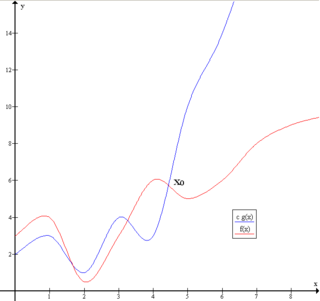Related Research Articles
In calculus, the chain rule is a formula that expresses the derivative of the composition of two differentiable functions f and g in terms of the derivatives of f and g. More precisely, if is the function such that for every x, then the chain rule is, in Lagrange's notation,

In mathematics, convolution is a mathematical operation on two functions that produces a third function. The term convolution refers to both the result function and to the process of computing it. It is defined as the integral of the product of the two functions after one is reflected about the y-axis and shifted. The integral is evaluated for all values of shift, producing the convolution function. The choice of which function is reflected and shifted before the integral does not change the integral result. Graphically, it expresses how the 'shape' of one function is modified by the other.

G, or g, is the seventh letter in the Latin alphabet, used in the modern English alphabet, the alphabets of other western European languages and others worldwide. Its name in English is gee, plural gees.

In mathematics, an integral is the continuous analog of a sum, which is used to calculate areas, volumes, and their generalizations. Integration, the process of computing an integral, is one of the two fundamental operations of calculus, the other being differentiation. Integration was initially used to solve problems in mathematics and physics, such as finding the area under a curve, or determining displacement from velocity. Usage of integration expanded to a wide variety of scientific fields thereafter.

In physics, the kinetic energy of an object is the form of energy that it possesses due to its motion.

Big O notation is a mathematical notation that describes the limiting behavior of a function when the argument tends towards a particular value or infinity. Big O is a member of a family of notations invented by German mathematicians Paul Bachmann, Edmund Landau, and others, collectively called Bachmann–Landau notation or asymptotic notation. The letter O was chosen by Bachmann to stand for Ordnung, meaning the order of approximation.

In physics, engineering and mathematics, the Fourier transform (FT) is an integral transform that converts a function into a form that describes the frequencies present in the original function. The output of the transform is a complex-valued function of frequency. The term Fourier transform refers to both this complex-valued function and the mathematical operation. When a distinction needs to be made the Fourier transform is sometimes called the frequency domain representation of the original function. The Fourier transform is analogous to decomposing the sound of a musical chord into the intensities of its constituent pitches.
In chemistry, the molar mass of a chemical compound is defined as the ratio between the mass and the amount of substance of any sample of said compound. The molar mass is a bulk, not molecular, property of a substance. The molar mass is an average of many instances of the compound, which often vary in mass due to the presence of isotopes. Most commonly, the molar mass is computed from the standard atomic weights and is thus a terrestrial average and a function of the relative abundance of the isotopes of the constituent atoms on Earth. The molar mass is appropriate for converting between the mass of a substance and the amount of a substance for bulk quantities.
In mathematics, a function from a set X to a set Y assigns to each element of X exactly one element of Y. The set X is called the domain of the function and the set Y is called the codomain of the function.

In thermodynamics, the Gibbs free energy is a thermodynamic potential that can be used to calculate the maximum amount of work, other than pressure-volume work, that may be performed by a thermodynamically closed system at constant temperature and pressure. It also provides a necessary condition for processes such as chemical reactions that may occur under these conditions. The Gibbs free energy is expressed as
Callisthenia is a genus of moths in the subfamily Arctiinae. The genus was erected by George Hampson in 1900.
Callisthenia angusta is a moth of the subfamily Arctiinae. It is found in French Guiana.
Callisthenia lacteata is a moth of the subfamily Arctiinae first described by Arthur Gardiner Butler in 1878. It is found in the Amazon region.
Callisthenia plicata is a moth of the subfamily Arctiinae first described by Arthur Gardiner Butler in 1877. It is found in the Amazon region, Peru and Espírito Santo, Brazil.
Callisthenia ruberrima is a moth of the subfamily Arctiinae. It is found in the French Guiana.
Callisthenia ruficollis is a moth of the subfamily Arctiinae. It is found in the French Guiana.
Callisthenia schadei is a moth of the subfamily Arctiinae. It is found in Paraguay.
Callisthenia truncata is a moth of the subfamily Arctiinae. The type location is Colorado.
Callisthenia variegata is a moth of the subfamily Arctiinae first described by Francis Walker in 1865. It is found in the Amazon region and Peru.
Several genera of the Lithosiini tribe of lichen moths are placed as incertae sedis due to the uncertainty of their phylogenetic relationships within the tribe.
References
- ↑ Beccaloni, G.; Scoble, M.; Kitching, I.; Simonsen, T.; Robinson, G.; Pitkin, B.; Hine, A.; Lyal, C., eds. (2003). "Callisthenia costilobata". The Global Lepidoptera Names Index . Natural History Museum . Retrieved April 27, 2018.